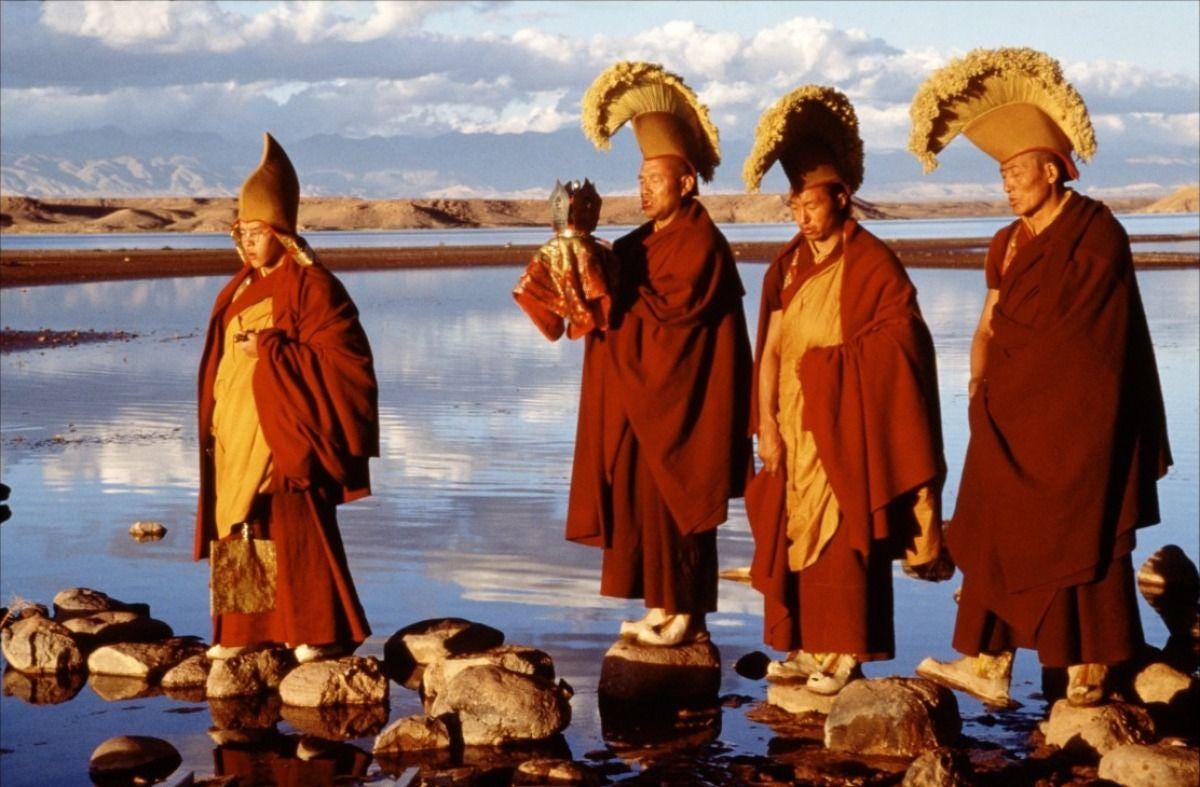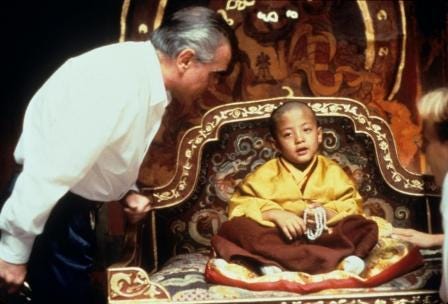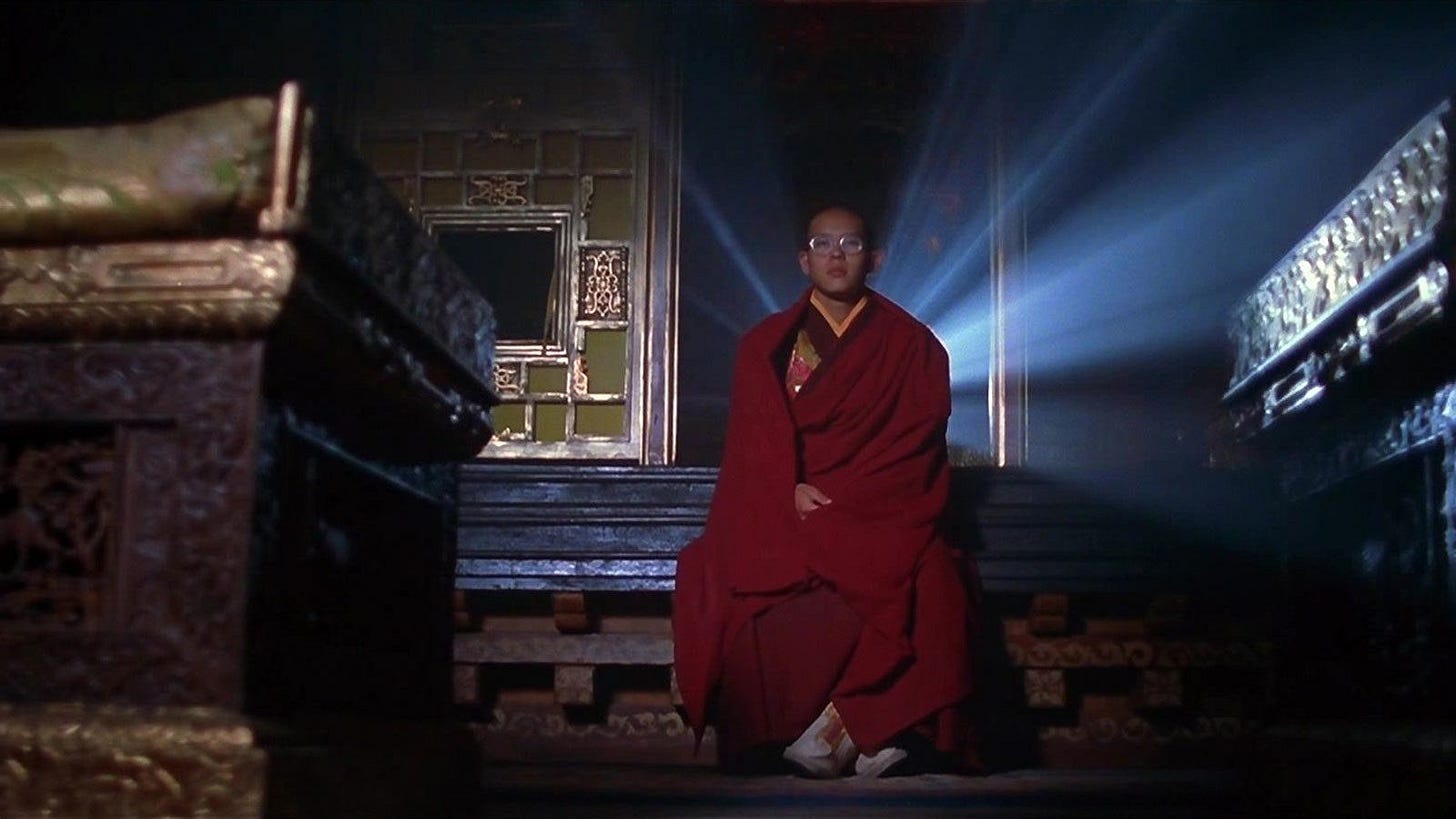Scorsese's Hidden Masterpiece
Kundun & In Search of Kundun
Kundun (1997) is a stunning and profound biopic of the early life of His Holiness the 14th Dalai Lama. A few months ago, I had no idea this Scorsese film even existed. I learned about it because it was being screened at the Tribeca Film Festival to honor the 90th birthday of His Holiness.1 The making of documentary In Search of Kundun directed by Michael Henry Wilson is a worthy companion piece. It includes incredible observational footage from Morroco where the film was shot, and has interviews with His Holiness and several Tibetan cast members and consultants.
Kundun tells the story of His Holiness’s life from his early childhood up until his exile to India in 1959. (Kundun is a Tibetan honorific title for the Dalai Lama that roughly translates to “the presence.”) His Holiness was born July 6, 1935 in the small village of Taktser. His parents were farmers and he was one of seven children. When he was two years old, he was discovered by a traveling group of monks and passed a series of tests that proved he was the 14th Reincarnation of the Dalai Lama. The film follows him through his religious education and as political tensions began to rise between China and Tibet. By 1950 Mao Zedong was the leader of the newly renamed People’s Republic of China, and there was a massive effort to reshape society to fit communist ideology. In October 1950 Chinese military forces invaded Tibet and claimed to liberate the country from its theocratic rule. Ever since then there have been systemic efforts to erase Tibetan culture and language, and violent crackdowns on protestors.2
Kundun begins years before the fateful invasion in 1950 and is bursting with color and exquisite details. The production designer Dante Ferreti worked closely with His Holiness to recreate his childhood home and the monasteries where he lived. Roger Deakins’s masterful cinematography is able to capture mountainous vistas and intimate point of view shots from His Holiness as a child.3 Brief moments of Buddhist monks working on a sand mandala, a large meticulous patterned design created out of colored sand to represent the transience of all things, are used throughout the film to great effect. And there are several scenes in which traditional dances and religious ceremonies are highlighted. Splendorous images paired with a lively score by Philip Glass create a vivid picture of a vibrant culture shaped by Buddhism.
This is not a film that revolves around a fast paced plot, but instead focuses on the inner and spiritual life of the protagonist. We see His Holiness grow from a child with a shallow understanding of Buddhism into an adult who has to put his faith into practice as a leader. Scorsese finds a good balance between portraying His Holiness as a thoughtful spiritual leader and also showing his doubts and flaws. The scenes of His Holiness’s childhood are compelling because he seems like an ordinary boy who misses his family and is somewhat overwhelmed by his fate. Were His Holiness to be portrayed as perfect from the start, then the film would be far less impactful. His faith in nonviolence and his own worthiness to lead are tested several times as he becomes a young adult.
It is not a flawless film. All the actors speak English when events take place in Tibet, China, and India, which detracts from the realism of the story. So much of Tibetan culture is captured visually, and if actors could speak Tibetan, then this would have been a valuable resource for future generations. (There has always been a reticence among American audiences to read subtitles, so this is my guess as to why the film was made in English.) Unfortunately the 17-year old actor who played the older version of His Holiness later in the film was not always able to convey the stakes of the difficult choices he had to make. However, several cast members were excellent, especially the monks and advisors to His Holiness, who had a compelling gravitas and sense of urgency in their scenes.
Watching the documentary In Search of Kundun adds a deeper meaning to the film, because we get to know the significance of the project to the Tibetan cast members and consultants. There are a handful of interviews with the real Dalai Lama in which he discusses his decision to let Scorsese make his biopic and explains how he was involved with the filmmaking process. Tibetans were flown in from various diaspora communities from across the globe in order to act in Kundun and work as consultants. Several of the actors talked about how meaningful it was to work on a film that celebrated their culture and history. Lead production consultant Namgyal L. Taklha, the sister-in-law of His Holiness, speaks about the unique experience of accurately translating her family’s history to the screen.
The documentary also shows Scorsese at his best. He is jovial on set and takes great care when working with some of the child actors. It is strange that a director known for violent gangster films is portraying the 14th Dalai Lama, a man dedicated to nonviolence. But that apparent contradiction is pointed out to Scorsese. He explains that he wanted to understand the deep commitment and faith in nonviolence. There are a handful of visceral violent scenes in Kundun that challenge His Holiness’s faith in nonviolence. The foreboding danger of some of Scorsese’s gangster films is also present in the tense scenes between Mao and the Dalai Lama. But Kundun is strikingly different than Scorsese’s best known films. It has a sensitivity and thoughtfulness that is seen in Scorsese’s riskier projects like Age of Innocence, The Silence, and Killers of the Flower Moon.
I would argue any day that Kundun is one of Scorsese’s best films, but there is a reason that many people have never seen it. Kundun is impossible to stream online, with the exception of a bootleg version on YouTube. To watch a high quality version you’d have to buy it on DVD or order through the public library system. Almost as soon as it was completed in 1997, its production company Disney tried to limit the theatrical release because of pressure from the Chinese Communist Party (CCP). On a trip to China a year later, CEO Michael Eisner met with Chinese government officials to offer his apologies for green lighting the picture. Some critics and scholars have argued this was a pivotal moment that paved the way for the CCP to censor films from major studios that dealt with sensitive political topics.4 Scorsese’s recent screening at the Tribeca Film Festival in June 2025 was one of the first major public screenings of the film in years. As of this writing, Disney has still not allowed Kundun on any streaming platforms.
Kundun is an inherently political film because it is about Tibet, but it is most importantly a spiritual journey. Films about faith can sometimes seem irrelevant to those who don’t practice that particular religion or are secular. But as an atheist, I would argue that films about faith can still be an important reminder of shared humanistic values of compassion, nonviolence, and respect for all beings. I wanted to write about Kundun because I found it deeply moving. Several scenes have stayed with me, especially a poetic montage towards the end of the film that intercuts His Holiness’s journey into exile with abstract Buddhist imagery. Kundun shows the joys, revelations, and hardships of a spiritual life in a visceral and sacred way.
When the film ends, His Holiness is in exile in India and the CCP has complete control of Tibet. Since going into exile, His Holiness has spent his life building a strong Tibetan diaspora community in India and across the globe. He has worked to help create a democratic government in exile and has encouraged others to take leadership roles. His Holiness continues to publicly advocate for religious and cultural freedom in Tibet.5
One film cannot change the world, but Kundun should be made available more widely. It is a powerful reminder of the faith and culture that so many Tibetans across the globe are working to preserve.
***
To watch a high quality version of both films, search for the Kundun DVD at your local library/university or order through interlibrary loan. In Search of Kundun is included in the special features. Kundun is also available in the Martin Scorsese: Films of Faith collection. I do not approve of the practice, but both films can also be found on YouTube.
“Tribeca Festival hosts rare Screening of Kundun featuring remarks by director Martin Scorsese,” International Campaign for Tibet, June 20, 2025, https://savetibet.org/tribeca-festival-hosts-rare-screening-of-kundun-featuring-remarks-by-director-martin-scorsese/.
“China/Tibet: 1950 to Present,” University of Central Arkansas, https://uca.edu/politicalscience/home/research-projects/dadm-project/asiapacific-region/chinatibet-1950-present/.
Roger Deakins is a legendary talent and would later win Best Cinematography Oscars for Blade Runner 2049 (2018) and 1917 (2020). To learn more about his work on Kundun, I recommend reading Kundun: Raising Tibet in the Desert by Stephen Pizzello from American Cinematographer Magazine.
Kayleigh Donaldson, “The Story of Kundun that Disney Tried to Bury,” SlashFilm, December 8, 2022, https://www.slashfilm.com/1131322/the-story-of-kundun-the-martin-scorsese-film-that-disney-tried-to-bury/.
Read the latest news and developments on Tibet by visiting the International Campaign for Tibet.




